When planning an unforgettable modern wedding, there are many sources of inspiration to choose from. One of the most reliable is, of course, traditions, shared and preserved by people and cultures from all over the world. Cyprus and its inhabitants are famous for their warmth and hospitality, as well as ancient wedding customs that had been in existence before time was time. These traditions are still well-loved and followed by people across the Island of Love, while maintaining and transmitting them falls mostly to new couples, their families and friends that incorporate them into their wedding day celebrations. Traditional music performers and singers also play a key part in keeping the customs alive, together with traditional dance groups and folklore societies contributing to the promotion and preservation of wedding practices. So if you are looking for something to give your wedding that touch of romance, why not try a traditional wedding in Cyprus?
The Essential Cypriot Wedding: Ancient Customs and Modern Practices
What are Cypriot wedding traditions? Originally, Cypriot weddings are supposed to be quite important occasions, lasting three days called Oi Paramoni, O Gammo, and O Antigammo, with specific parts and rituals assigned to them. These are in their essence the eve of the wedding, the wedding itself and the following after-wedding party. The celebration will take up most part of the day each time, lasting from morning to morning, incorporating music, lively dancing and an abundance of delicious food. This article will take you through the authentic and colorful world of traditional Cyprus weddings to showcase their unique beauty and charm. Needless to say, even though some couples prefer to trade rural settings for stylish urban locations, religious rituals for civil wedding ceremonies, and street parties for sophisticated hotel receptions, they always find a way to incorporate true Cypriot traditions into the celebration.
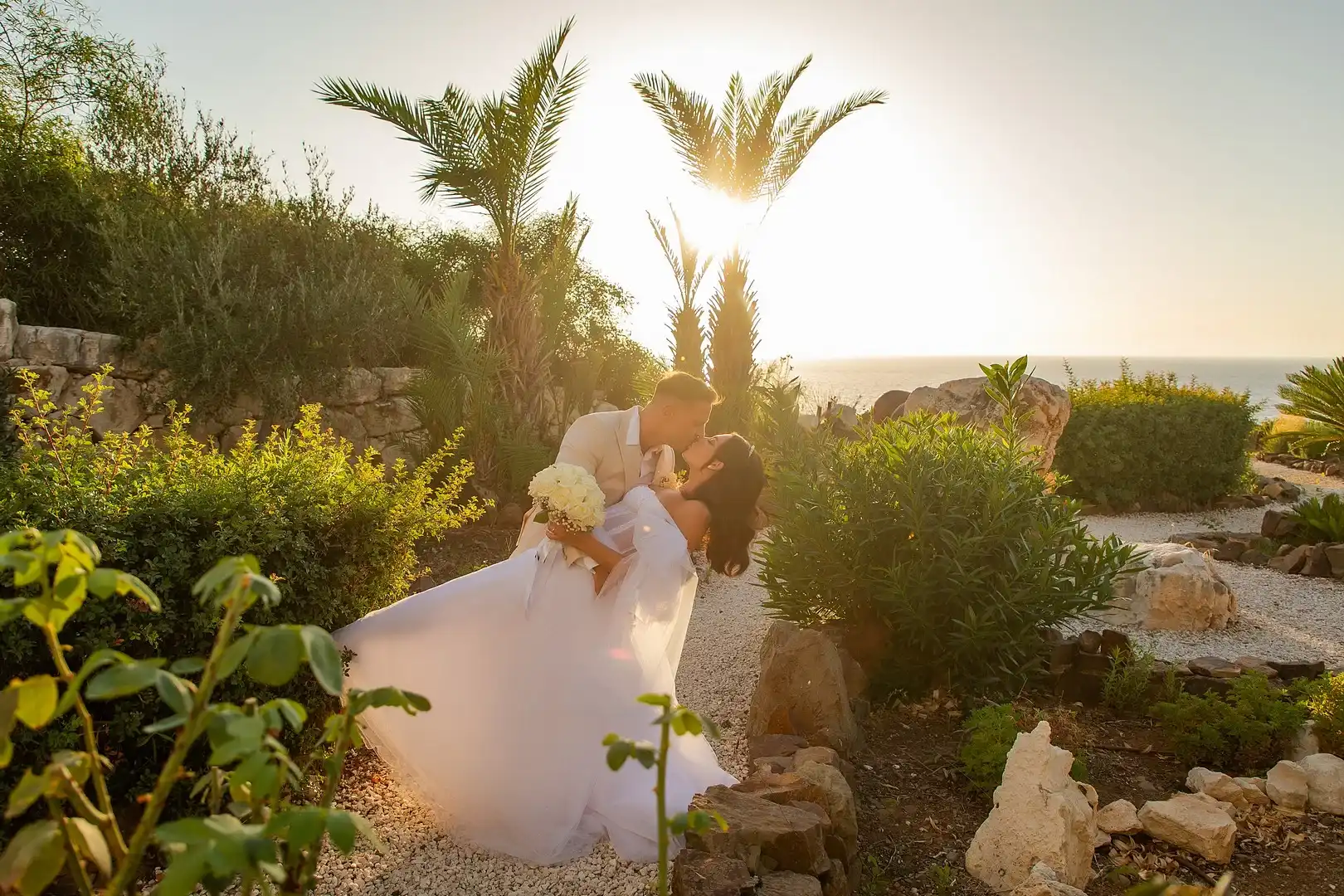
Pre-Wedding Traditions
When it comes to a wedding in Cyprus traditions play an especially significant role in all wedding preparations. With the predominance of rural communities in Cyprus in the past, many of those customs originate and can truly be experienced in villages, such as the famous Lefkara.
Marriages in Cyprus used to be arranged through the services of matchmakers or Proxenitra as they were known. They would talk to the parents of the bride-to-be on behalf of the prospective groom and attempt to convince them of his outstanding qualities. Such things as the young man’s income, personality and social standing were among the most important qualities to consider. If he came from another village, it was the parents’ responsibility to visit the place and make sure that he was worthy of their daughter’s hand by asking those who knew him about his character.
If the parents found the match satisfactory, what would follow is a betrothal meeting or logiasma, together with other close relatives like godparents, aunts and uncles, grandparents, siblings. Accompanied by a priest, a prenuptial agreement would be conducted, followed by a feast.
Days of the week are symbolic in Cyprus wedding traditions, and so an engagement would typically be held on a Sunday, just as a wedding would. During the party, the couple exchanged rings and handkerchiefs, while their parents agreed on their corresponding tasks preceding the wedding. It was the duty of the bride’s father to provide the house for the couple – a challenging responsibility, since he was supposed to collect the stones for the construction himself. The friends and other family members would help to build the house. At the same time, the groom’s relatives were the ones to take care of the wedding feast and prepare some special types of festive foods, such as glistarkes that the bride’s family will hand out as wedding invitations.
The invitations themselves were handed out either by the family members of the bride and the groom or the honor was reserved for the chief bridesmaid. While living in a small rural community, anyone from the bride’s or the groom’s village would have a de facto invitation and be welcome to attend the wedding ceremony.
Wedding Preparations
Wedding Cypriot traditions usually involved a whole week of preparations and associated rituals. Apart from the bride (Nymphi) and the groom (Gambros), there are several other important actors taking part in the celebration. A great number of customs also require the participation of a best man “Koumbaro” and maid of honor “Koumera”, as well as violin and lute players, known as violari and laoutari respectively.
The ceremony that takes place during the first day is called the Paploma and involves preparing the couple’s matrimonial bed. This festive ritual includes a lot of music, singing and dancing, as the couple’s mattress is sewn together by the young girls from their family and friendship circle and filled with pure wool. Every corner of the mattress is then decorated with a red ribbon in the form of a cross as a sign of blessing and fertility. After the mattress is ready, the people present would dance with it above their heads to the traditional violin and lute tunes, and then a baby from the family would be rolled across the mattress to wish the couple children of their own. Another tradition, known as “ploumisma” would have the relatives throw money onto the mattress to secure the bride and groom’s future as free of cares and poverty. Relatives would also tip the musicians as a token of appreciation, and offer their wishes of future prosperity to the future newlyweds. In the evening, it is also common for the bride’s parents to host a banquet called Trabezi at their home for everyone, including the future in-laws.
On the morning of the wedding itself, the Stolisma ceremony, loosely translated as the “decoration” or “dressing”, is carried out. It consists of many parts that symbolize the parting and separation of the couple from their families and becoming independent adults. Both the bride and the groom go through these preparations separately and do not see each other until the ceremony later in the day. The parts are the shaving of the groom, the “dancing” of the wedding clothes, the dressing of the bride and the groom, the Zosimon and the Kapnisman rituals.

Shaving of the groom is attended by his friends and relatives. Traditionally, the best man is the one to give the groom a close shave, while accompanied by the music and songs of the violin and lute players. Alternatively, a professional barber may take up the task with the best man assisting him. The gathered family members then reward the musicians and the barber by placing money on a plate in front of them. It is the time of fun and joy, and many of the attendees are free to play pranks on and otherwise “torment” the groom as a part of the ritual.
Dancing of the wedding clothes happens next. The clothes of the groom and those of the bride are put into a traditional ceremonial tsesto basket by the best man and the bridesmaid respectively. They are covered with a red cloth and blessed by a priest, walking around them with a censer with burning incense. The number three is significant here, as it represents the Orthodox Holy Trinity. Afterwards, accompanied by violins and songs, three women and three men dance with the bride’s and groom’s clothes. More dancers are allowed to participate in the ritual, as long as their number remains odd.
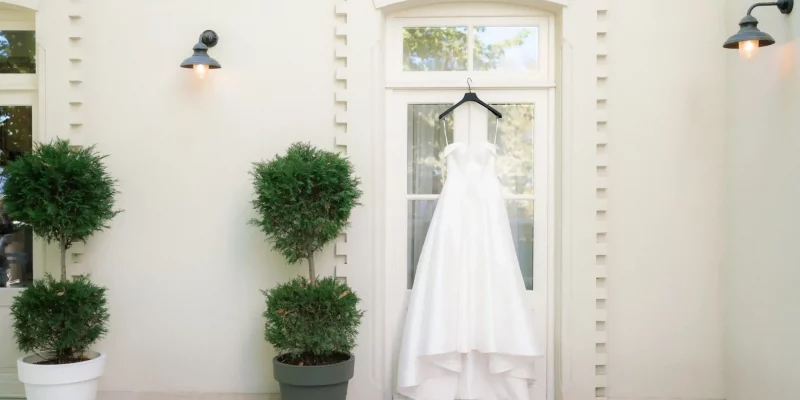
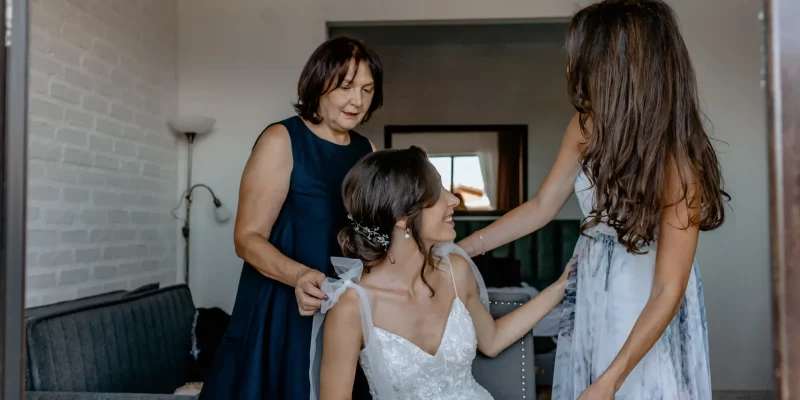
Dressing of the bride and the groom are equally complex customs, once again involving the presence of the best man and the maid of honor. In the old days, the best man would be the one to dress the groom in a shirt and vraka, the breeches traditionally worn by Cypriot men, while the groom’s parents would help him put on his belt (Zostra) and purse. The mother of the groom would wrap a scarf around his neck. At the same time, the bridesmaid would dress the bride, adorn her with jewelry and place a veil on her head. As a part of older traditions, the mother of the bride would also place a tsemberi, the traditional women’s headscarf in Cyprus, on the bride’s head. The soon-to-be-married couple may then be sprinkled with rose water to ward them against evil spirits and misfortune.
The Zosimon ritual is known as the “red scarf blessing”, and constitutes tying a red belt, kerchief or scarf around the waist of the bride and the groom by each of their parents. In some areas, the couple are blessed in this way by other relatives, such as godparents, siblings, aunts and uncles, as well as grandparents. This is both a wish for fertility, and protection against the evil eye as the bride and the groom set off together to create a new life for themselves.
The Kapnisman or “holy smoke” ritual closely follows the blessing of the red scarf and involves burning incense and dried olive leaves in a small highly decorative silver vessel, “kabnistiri”. The family members would pass this censer over the bride and groom three times for the smoke to purify and protect them, getting rid of any evil spirits. Sometimes rose water would be sprinkled on them or used to wash the hands of their guests for luck and prosperity. In the olden days, they used to then smash the holding plate in which the censer had stood, as well as the plate used to collect gift money for the musicians during this part.
Once the ceremony has come to an end, the bride and groom make their way to church or the ceremony venue, often followed by violin and lute music in the form of a serenade.
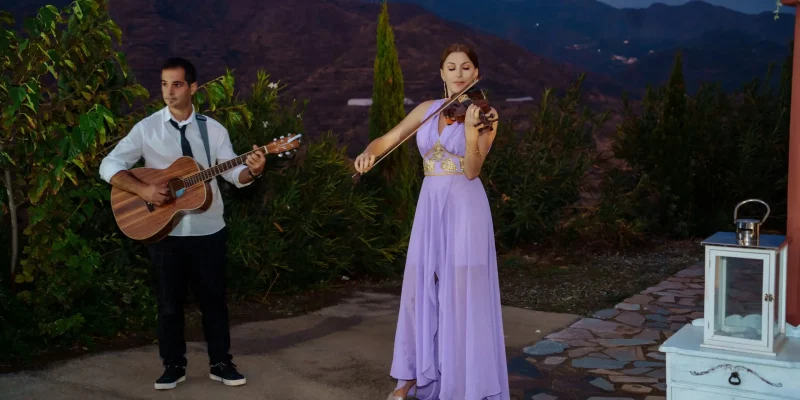
Orthodox Wedding Ceremony
Cyprus Orthodox wedding traditions are extremely widespread on the island, due to the predominance of Orthodox faith among Cypriots.
In Cyprus, the groom waits for the bride by the entrance to the church, holding her bouquet. It is the duty of the father to accompany the bride to the church and give her away to the groom while still outside. Then the couple will walk the aisle together and the ceremony will start. At the beginning of the service, they will be joined by their parents, the maid of honor and the best man, who will stand by them for the whole duration of the ceremony.
The service is usually chanted in ancient Greek and includes the traditional elements Christian religious ceremonies, such as the ceremonial prosfora (bread) and koumandaria (red Cypriot wine), which the couple are expected to eat and drink.
A very important attribute of traditional Cypriot weddings are Stephanas – ornamental crowns that the bride and the groom wear as a part of the ceremony. The origin of these crowns dates back to ancient Greece when the crowns were made of natural materials, such as olive branches, lemon leaves, grape vines, and even asparagus. Nowadays, many couples opt for more precious and modern materials, such as silver, gold, pearls and jewels. The two Stefanas are a symbol of two separate circles of life and are connected as one with a joining ribbon, which should never be cut. The couple are crowned and united just as the crowns are joined with the ribbon. Before the ribbon is attached, the best man and the maid of honor interchange the crowns on the couple’s heads three times as a part of the ritual.
While wearing the Stephanas, the couple exchange the wedding rings three times, join hands and then embark on the Dance of Isaiah, a ceremonial walk around the gospel table, with the Koumbaros and Koumera holding their Stephanas in place. Later the priest blesses the couple and removes their crowns, wishing them a long and prosperous life together. As a final part of the ceremony, he separates the couple’s joined hands, showing them that only God can break their marriage.
The marriage crowns remain important to the couple throughout their life together and traditionally remain in their house on a special display that may be placed above the bed. As the ribbon that connects the stephanas symbolizes an ever-lasting union between the two newlyweds, it is advised that they keep it intact forever. The blessed Stefanas are supposed to bring prosperity, happiness and many children to the couple. Some people even choose to be buried with them, so their significance can hardly be underestimated.
When the bride and the groom are officially married, koufetta (sugared almonds) are given to the guests, and rice or rose petals can be thrown by the attendees, symbolizing the wishes for the couple’s longevity and happiness.

Reception and Post-Ceremony Traditions in Cyprus Weddings
The ceremony is typically followed by a cocktail reception outside the church or at another designated venue, like a cafe or a restaurant. This is the Chairetisma or “congratulation” part of the Cyprus wedding reception traditions. On arrival the guests are given a small gift, which is usually a piece of paper-wrapped cake, some other sweets or souvenirs. Guests would form a line to approach and congratulate the newlyweds, who stand on a raised platform or dais. Then the guests offer their formal greetings to the married couple and their parents and enjoy socializing at the cocktail buffet.
It is customary for the guests to bring money and other gifts to this part of the reception. They are placed in a basket or given to the family members responsible for the gift table. The gift table sits right next to or behind the greeting platform. Also, as the tradition of building a house for the couple has evolved in the modern times, it is now quite common for the father of the bride to give the newlyweds a house as a wedding present.
An unusual characteristic of Cypriot wedding receptions is that an extended group of people, such as distant relatives, neighbors and acquaintances, are often invited only to this part but not to the wedding dinner. So do not be surprised to see a lot of food at the cocktail ceremony, as the number of attendees can sometimes reach as many as 1000, 1500 or even 4000 people. The couple would remain there all evening until the last guest had their chance to see them. Afterwards, it’s time for the wedding dinner, cake, and a dance party.
The dinner part of the reception usually lasts well into the night and includes a lot of music, dancing and fantastic food, to which we devote a special section later in the article. The highlight of the evening is the traditional Cyprus wedding dance of the couple, marking their first activity as a married couple. During this dance, the guests demonstrate one of the traditional Cyprus wedding favors, pinning money on the clothes of the bride and the groom, so that they can pay off the cost of the wedding and start their new life together debt-free.
Also, before the dance and other festivities commence, the unmarried friends of the bride would write their names on the soles of the bride’s shoes. At the end of the evening, when the bride takes them off, the name that remains is believed to belong to the woman who will marry next. Another popular custom is catching the bridal bouquet and garter, that are tossed by the bride and the groom respectively.
Other wedding dances include the Tsamiko, the Tsiftetelli, the Sirtaki and eventually the Zeipekiko, all of which are popular in Cyprus folk dancing tradition. Closer to the end of the party, the guests may also engage in the Vareda, loosely translated as a “heavy” or a “drunk man” dance, because of the variety of steps in it – some may be quite light but clothes are expected to be quite heavy-footed.
Music equally plays an integral role in Cypriot weddings and may vary from traditional folk songs sung by family members during dinner time to dancefloor beats that keep the guests on their feet all night long. Many couples opt for DJ performances or live bands that often play popular Greek tunes to add that special touch to the celebration.
Traditional games and competitions may be held during reception, and they too involve music and dancing. For example, Bouzouki competitions would have two teams playing this small guitar-like instrument and trying to outperform each other in its mastery and knowledge of traditional folk songs. Kalamatianos dancing is another game, in which the guests split into couples, form circles around the wedding musicians playing mandolins or lutes, while taking turns leading each dance step until everyone joins in at once.
On the day after the wedding, or the O Antigamo, some part of the celebration is still in progress. The night before, for instance, the single women will share the reception almonds, koufetta, and the red ribbon from the ceremony, and place them under their pillows at night in order to dream about the man they are destined to marry. During the day, both sets of parents would prepare another banquet for close family and friends, and the bride would also have a special dark dress, made exclusively to be worn on this day, making it an important part of what to wear in Cyprus wedding traditions.
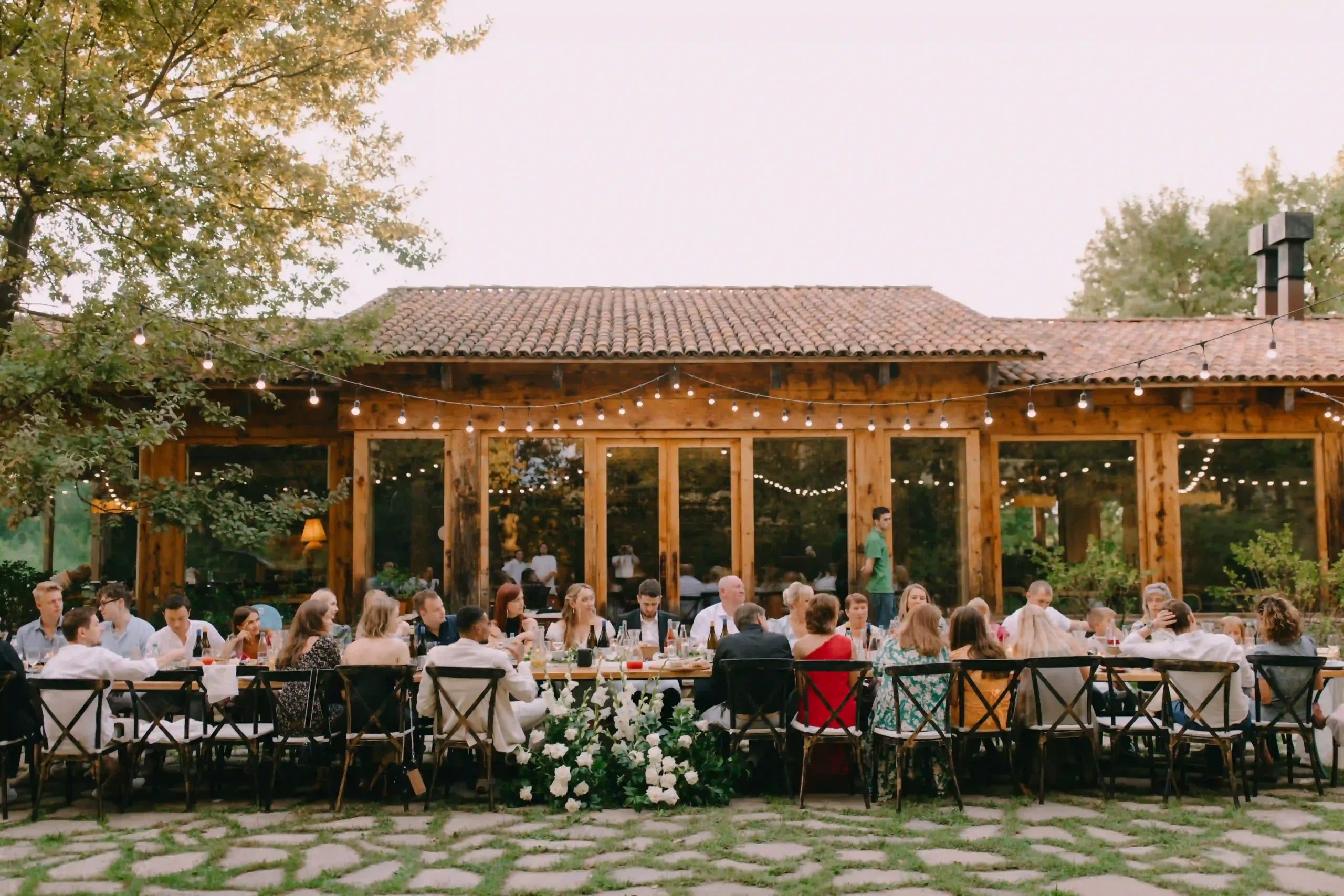
The Gastronomy: Traditional Cypriot Wedding Foods
Among the great variety of Cypriot traditional wedding foods and dishes, bread and meat based ones take central stage. Remember, even wedding invitations used to be handed out by the bride’s family in the form of ceremonial bread, called glistarkes. Prosfora bread is taken to the church to be sanctified and used in the ceremony itself. At the same time, koulouria biscuits, covered in sesame seeds, serve as decorations during the ceremony, to be later enjoyed by the guests at the reception.
Another dish that combines both bread and meat is resi. It is made from coarsely ground wheat boiled in meat broth. Its preparation is so delicate and time-consuming that it has become an entire pre-wedding ritual. In the old days, a whole village participated in the cooking, using wooden flails known as “faoutes” to beat the wheat before turning to grinding it either in a hand-made mill or the village’s olive mill, all that to the accompaniment of lively violin music. The wheat would then be left out in the sun to dry, before the bark was removed and it was taken to the village fountain to be washed. The meat for the broth would first be boiled, then mashed to ensure there were no bones left. Then the participants would slowly pour in the wheat and cook it in a cauldron over a low heat overnight, so it turns into porridge. Nowadays, this tradition is mainly kept alive by families from the Paphos and Limassol districts, with an annual resi festival taking place in Letymbou village in Paphos to safeguard this part of Cypriot cultural heritage from disappearing.
The sugared almonds or koufetta that were mentioned in connection with the wedding ceremony are also full of deep symbolism. The white sugar coating symbolizes purity, the shape of the sweets resembles that of an egg and thus represents fertility and the new life which begins with the marriage, and the hardness of the sugared almond stands for the endurance of marriage, while the overall sweetness of the treat symbolizes the happiness of the newlywed’s future life together. These are always odd in number and there are usually 33 almonds in total. This is meant to represent that the couple, akin to this indivisible number, should remain undivided. Koufetta are placed on the tray with the Stefana and are later given to the wedding guests by the bride and groom as they leave the church as husband and wife.
Similarly, in Cyprus weddings it is customary to offer sweet gifts to reception and ceremony guests. They are distributed among the guests by a bridesmaid or flower girl during the Chairetisma. Although nowadays many couples prefer everyday treats, like brownies, macaroons, cupcakes or pralines, there is a traditional type of biscuits that is baked in Cyprus for this very purpose. The traditional lukumia are made from semolina, butter and flour, filled with nuts like almonds or pistachios and then covered with icing sugar, which makes them a confectionery delight.
At the wedding dinner, many wheat and meat-based dishes are served to the guests as a part of the celebration. These include ophton klephtiko – large chunks of goat, mutton and beef, wrapped in aluminum foil and slowly cooked for hours in a traditional oven, souvlaki with local vegetables, makaronia tou phournou (a variety of pasticcio), koupepia (meat-stuffed vine leaves), kephtedes (meatballs), with roast potatoes and salad as garnish. Loukoumades donuts are served as dessert. These dishes can be accompanied by a variety of beverages, such as soft drinks, beer, different wines, ouzo and koniaki (Cyprus brandy) that guests toast to the health and prosperity of the couple.
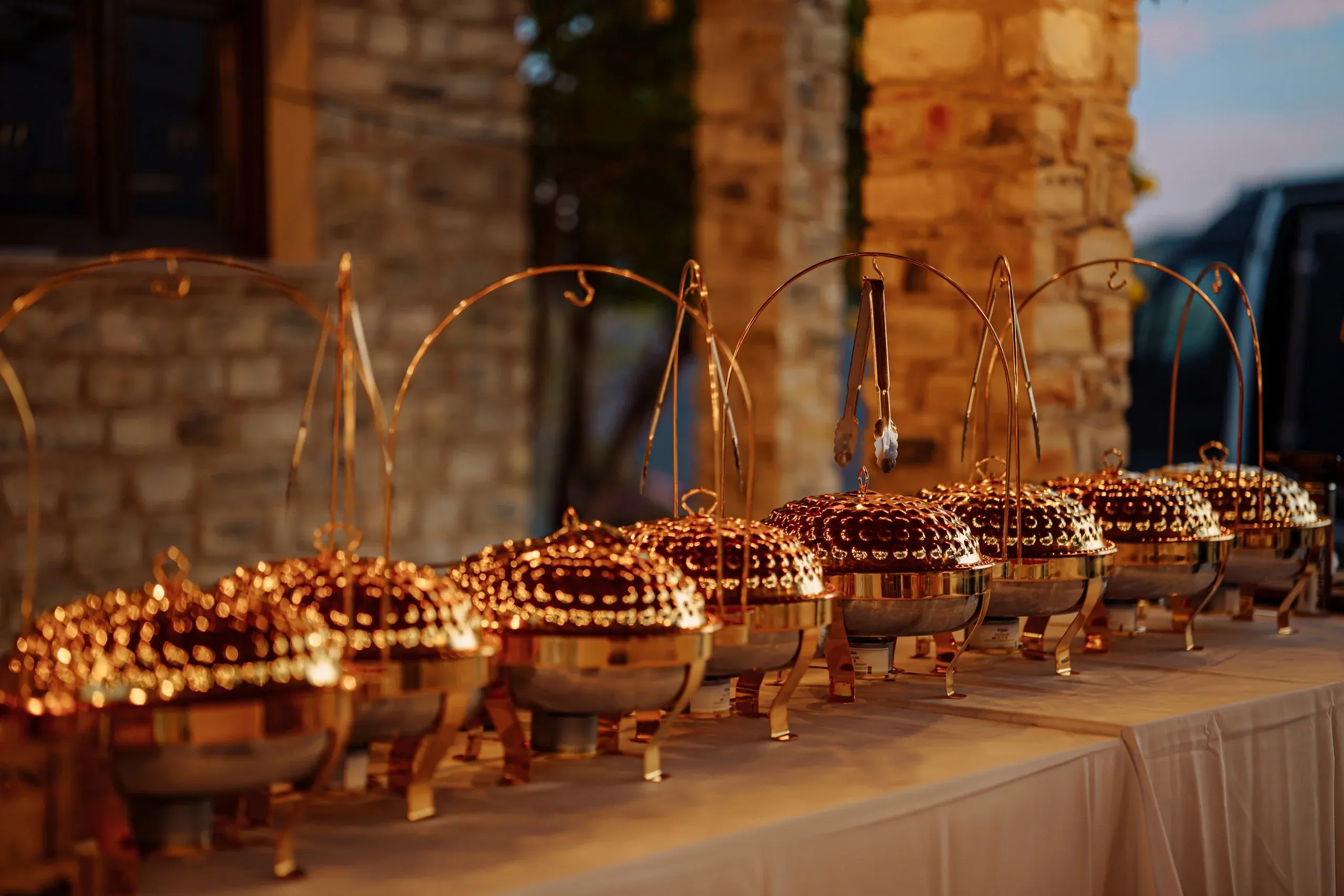
Conclusion
A traditional wedding in Cyprus is a journey full of excitement and solemnity not just for the bride and the groom but also for their families, friends and guests. The beauty and importance of these wedding customs and rituals shines bright in any setting or venue you may choose for a destination wedding in Cyprus. And so they can become a part of your big day as well, making it a memorable and romantic occasion that will bring everyone closer together and leave lasting warm memories for every person present.
Start planning the wedding of your dreams today!
Leave your inquiry and receive a detailed estimate within 1 day
Related Articles
Find more inspiring articles about breathtaking weddings in Georgia and Cyprus on our blog


